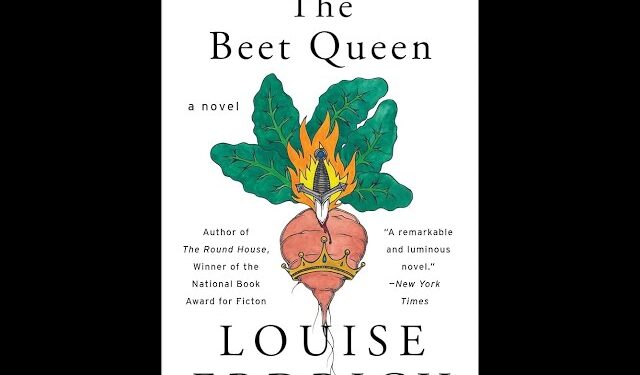Table of Contents
ToggleIntroduction
The Beet Queen Summary And Themes By Louise Erdrich Louise Erdrich’s The Beet Queen is a multi-layered book that examines the intricacies of identity, family, and survival in the Midwest of the United States. The story explores the lives of a number of characters, but it mostly centers on the intergenerational tale of Mary and Zelda, two sisters, and their battles with love, loss, and self-discovery.
The story, which is set in the made-up town of Argus, North Dakota, and spans many decades, follows the characters as they deal with the deep-rooted problems of race and class, the difficulties of growing up, and the significant influence of their Native American background.
In The Beet Queen, Erdrich—who is renowned for her poetic prose and nuanced examination of interpersonal relationships—explores issues of memory, belonging, and the ways that individual and familial histories influence one another. Erdrich creates a story that is both very personal and universally relatable through the novel’s interwoven characters and events, demonstrating the transformational potential of love, grief, and reconciliation.
Plot Summary of The Beet Queen
When Mary’s mother passes away tragically at the beginning of the book, the timid and bashful young girl must move in with her aunt, the glitzy and aggressive Zelda. Bitterness and unsolved difficulties characterize the relationship between Zelda and Mary’s mother, who had been estranged for years. Following the funeral, Zelda takes Mary in, and the two of them establish a complicated and unexpected friendship based on their common experiences.
Zelda is an independent, free-spirited woman who has experienced emotional and personal turmoil throughout her life. She is the complete antithesis of Mary, who is quiet and reserved and tries to make her way in a harsh and unwelcoming world. A significant portion of the novel’s plot is driven by the strong dynamic created by the two women’s contrast. Zelda works at a neighborhood diner where she eventually has an affair with Ralph, a good-hearted but unstable guy who later becomes entangled in their complex family history.
The story alternates between several characters whose lives touch Mary and Zelda’s as it progresses. One important character in the developing family drama is Sita, an Indigenous lady. Readers gain a fuller grasp of the different influences that influence the lives and decisions of the individuals as their histories and relationships are progressively exposed.
Read more
Mary grows up into a woman who strives for independence, much like Zelda, but she also grapples with her own internal struggles. She is burdened by the memory of her mother’s death and the unresolved trauma that stems from the distance between her and her mother’s past. As Mary matures, she finds herself confronting both her inner turmoil and her desire to forge her own identity. The novel follows her journey into adulthood as she comes to terms with the realities of love, loss, and her own sense of belonging.
Zelda, too, faces significant personal challenges throughout the novel. She is deeply affected by the death of her brother and the disintegration of her relationship with Mary’s mother. The impact of these experiences reverberates throughout the story, affecting her decisions and the way she interacts with others.
The central metaphor of the novel, which ties together the characters’ stories, is the “beet,” both as an agricultural product and as a symbol of the characters’ internal lives. The beets, cultivated in the fields surrounding Argus, serve as a backdrop to the larger themes of life and death, growth and decay, and the cyclical nature of existence. They also represent the idea of survival, as characters must work through their pain, trauma, and love in order to create meaning in their lives.

Themes in The Beet Queen
1 Family and the Complexity of Relationships: One of the novel’s most prominent themes is the complex and multifaceted nature of family. At the heart of The Beet Queen is the relationship between Mary and Zelda, two women who are forced together by circumstance yet come to understand and shape each other’s lives in profound ways. Their bond is one marked by tension, love, and a shared history of hardship. Both characters are products of their pasts, and their relationship is shaped by their individual traumas, desires, and dreams.
The novel shows that family is not always about unconditional love or harmonious relationships. Instead, it is a space where conflict, jealousy, longing, and reconciling with the past all intersect. The family dynamics in the book are fraught with contradictions, showing that families are as much about what remains unsaid as what is openly expressed.
2 Memory, Trauma, and Loss: The theme of memory is closely tied to trauma and loss in The Beet Queen. Many of the characters are haunted by their pasts, struggling with the death of loved ones and the lingering effects of these losses. Mary’s mother’s death, the tragic fate of Zelda’s brother, and the emotional scars from past relationships all weigh heavily on the characters, affecting how they interact with the world around them.
Memory is both a source of pain and a means of survival. For some characters, remembering is an essential way to maintain a sense of identity and purpose, while for others, it is a curse they must fight to overcome. The novel portrays the complex ways in which the past can shape the present, affecting how people move through life, their relationships, and their decisions.
3 Identity and Self-Discovery: The Beet Queen Summary And Themes By Louise Erdrich The Beet Queen explores the theme of identity, especially the internal struggle of trying to understand oneself in a world that often seems unwelcoming and challenging.
Mary’s journey, in particular, is one of self-discovery, as she tries to make sense of who she is in the wake of her mother’s death and the estranged relationship she has with Zelda. Her search for belonging and purpose leads her to question her place within the larger framework of family, society, and culture.
The Beet Queen Summary And Themes By Louise Erdrich The theme of self-discovery is also explored through the backdrop of Argus and its rural, isolated nature. The town becomes a character in itself, shaping the lives of those who live there.
Argus represents both a place of roots and restrictions, where the characters must confront their own personal limitations and desires. The tension between escaping and returning, as well as the need for community versus the desire for independence, is central to the characters’ search for identity.
4 Love and the Complexity of Romantic Relationships: Love, in its many forms, is a central theme in the novel. Romantic relationships in The Beet Queen are complex, often marked by unfulfilled desires, betrayal, and an inability to communicate.
Zelda’s relationship with Ralph, and the effects of her past affairs, illustrate the difficulties that arise when love is entangled with the weight of emotional baggage and trauma. Similarly, Mary’s experiences with love—both the love she seeks and the love she rejects—are colored by her past and the loss she has experienced.
The Beet Queen Summary And Themes By Louise Erdrich The novel suggests that love is not always a clear or easy emotion to navigate. Rather, it is something that must be negotiated and understood over time, often involving painful compromises and self-awareness. Love, as portrayed in the novel, is an emotion that exists alongside and in spite of hardship and loss.
Read more
5 The Native American Experience: The Beet Queen Summary And Themes By Louise Erdrich While The Beet Queen is primarily about family and personal relationships, it also touches on themes of identity within the context of the Native American experience. Several characters are grappling with their Indigenous heritage, including how to integrate their Native roots into their personal identities. This theme is explored through subtle references to the cultural dynamics of Argus and the ways in which Native American characters experience the intersection of their culture with mainstream American society.
The Beet Queen Summary And Themes By Louise Erdrich The Native American characters in the novel are portrayed as living on the periphery of both white and Native communities. This marginalization is evident in their struggles to find a sense of belonging and pride in a society that often erases their cultural identities. The novel touches on the theme of assimilation, as well as the complex legacy of colonization and its lasting effects on individual and collective identities.

6 Survival and Resilience: The Beet Queen Summary And Themes By Louise Erdrich At its core, The Beet Queen is a story about survival and resilience in the face of adversity. The characters, particularly Mary and Zelda, must learn how to navigate a world that is frequently cruel and indifferent. Survival, in the novel, is not just about physical endurance, but also about emotional and psychological endurance. The characters must cope with their pasts, reconcile with their losses, and continue to move forward in a world that often seems too harsh to bear.
The Beet Queen Summary And Themes By Louise Erdrich The novel portrays resilience as a multifaceted trait, one that requires both personal strength and the support of others. It suggests that survival is not just about enduring hardship, but about finding ways to create meaning and maintain hope in the face of life’s trials.
Read more
(FAQ)
1 What is The Beet Queen about?
The Beet Queen is a novel that explores the lives of several characters, focusing primarily on the complex relationship between two sisters, Mary and Zelda. Set in rural North Dakota, the story spans several decades and touches on themes of family, loss, identity, and survival. The novel also delves into the experience of Native American characters and the challenges they face in a society that marginalizes their heritage.
2 Who are the main characters in The Beet Queen?
The central characters of The Beet Queen are Mary and Zelda. Mary is a quiet, introspective young woman who struggles with her identity and her connection to her family. Zelda, her aunt, is a glamorous and independent woman whose life is filled with emotional turbulence. Other important characters include Ralph, with whom Zelda has an affair, and Sita, an Indigenous woman who plays a key role in the family’s story.
3 What is the significance of the beet in the novel?
The beet serves as a central metaphor in The Beet Queen, symbolizing both the characters’ survival and their internal lives. Just as the beet grows in the harsh, rural landscape, the characters must navigate their personal pain and trauma in order to find meaning and purpose. The beet also represents the cyclical nature of life, with its themes of growth, decay, and rebirth.
4 What are the major themes of The Beet Queen?
Some of the major themes in the novel include family dynamics and the complexity of relationships, the impact of memory and trauma, the search for identity, love and romantic relationships, the Native American experience, and the resilience required to survive hardship.
5 How does the novel address the Native American experience?
The Native American experience in The Beet Queen is portrayed through characters who are grappling with their cultural identity. The novel addresses themes of marginalization, assimilation, and the lasting effects of colonization, showing how these characters navigate their lives between their Native roots and the dominant culture.
6 Is The Beet Queen a standalone novel?
Yes, The Beet Queen is a standalone novel, though it is part of Louise Erdrich’s larger body of work that often includes overlapping characters and themes. Many of Erdrich’s novels are set in the fictional town of Argus and explore interconnected stories of love, loss, and survival.
Read more

















